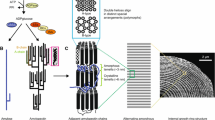Summary
Root tips of radish,Raphanus sativus, were fixed in glutaraldehyde followed by osmium tetroxide. The fine structure of young root hairs, not exceeding about 130μ, in length, was studied to relate their apical growth pattern to their cytoplasmic organization. The cytoplasm in the terminal 3–5μ it of the root hair is characterized by an electron dense matrix in which lie numerous smooth-surfaced vesicles, large irregularly-shaped fibrous inclusions, and clusters of ribosomes. Other organelles are largely or entirely excluded from this region. Farther than about 5μ, from the tip, the hair cytoplasm is filled with plastids, rough endoplasmic reticulum, mitochondria, and dictyosomes. The latter produce smooth vesicles similar in size and morphology to those present in the apical dome. Vesicles of a different kind appear in the peripheral cytoplasm along the entire length of the hair. These vesicles possess an alveolate or chambered coat about 20 mμ thick and have a diameter of about 85 mμ, including coat. They originate by evagination from the large, smooth-surfaced vesicles in the vicinity of dictyosomes. It is suggested that proteins and carbohydrates are concentrated in the dictyosomes and then segregated in the smooth vesicles released from the dictyosome cisternae. The coated vesicles which bud from the smooth vesicles may serve to isolate the proteins and transport them to the hair surface for participation in wall synthesis. The smooth vesicles are believed to convey carbohydrates to the region of active wall extension at the hair apex.
Similar content being viewed by others
References
Bonnett, H. T., Jr., and E. H. Newcomb, 1965: Polyribosomes and cisternal accumulations in root cells of radish. J. Cell Biol.27, 423.
Bowers, B., 1964: Coated vesicles in the pericardial cells of the aphid (Myzus persicae Sulz). Protoplasma59, 351.
Bruni, C., and K. R. Porter, 1965: The fine structure of the parenchymal cell of the normal rat liver. I. General observations. Amer. J. Pathol.46, 691.
Fawcett, D., 1965: Surface specializations of absorbing cells. J. Histochem. Cytochem.13, 75.
Gray, E. G., 1961: The granule cells, mossy synapses and Purkinje spine synapses of the cerebellum: light and electron microscope observations. J. Anat.95, 345.
Larson, D. A., 1965: Fine structural changes in the cytoplasm of germinating pollen. Amer. J. Bot.52, 139.
Mollenhauer, H. H., 1964: Plastic embedding mixtures for use in electron microscopy. Stain Technol.39, 111.
—, and. W. G. Whaley, 1963: An observation on the functioning of the Golgi apparatus. J. Cell Biol.17, 222.
Newcomb, E. H., 1964: Cytoplasmic fine structure in differentiating xylem elements. Amer. J. Bot.51, 668 (abstract).
—, and H. T. Bonnett, Jr., 1965: Cytoplasmic microtubule and wall microfibril orientation in root hairs of radish. J. Cell Biol.27, 575.
Peterson, M. R., and C. P. Leb1ond, 1964: Synthesis of complex carbohydrates in the Golgi region, as shown by radioautography after injection of labeled glucose. J. Cell Biol.21, 143.
Revel, J. P., and E. D. Hay, 1963: An autoradiographic and electron microscopic study of collagen synthesis in differentiating cartilage. Z. Zellforsch. Microskop. Anat.61, 110.
Rosen, W. G.: 1964: Chemotropism and fine structure of pollen tubes. In: Pollen Physiology and Fertilization (H. F. Linskens, editor). North Holland Publ. Co., Amsterdam, 159–166.
Rosen, W. G., S. R. Gawlik, W. V. Dashek, and K. A. Siegesmund, 1964: Fine structure and cytochemistry ofLilium pollen tubes. Amer. J. Bot.51, 61.
Roth, T. F., and K. R. Porter, 1962: Specialized sites on the cell surface for protein uptake. In: Fifth International Congress for Electron Microscopy, Philadelphia 2, LL-4 (S. S. Breese, Jr., Editor). Academic Press, New York.
— —, 1964: Yolk protein uptake in the oocyte of the mosquitoAedes aegypti L. J. Cell Biol.20, 313.
Schnepf, E., 1961: Quantitative Zusammenhänge zwischen der Sekretion des Fangschleimes und den Golgi-Structuren beiDrosophyllum lusitanicum. Z. Naturforsch.16, 605.
Sievers, A., 1962: Beteiligung des Golgi-Apparates bei der Bildung der Zellwand von Wurzelhaaren. Protoplasma56, 188.
Wissig, S. L., 1962: Structural differentiation in the plasmalemma and cytoplasmic vesicles of selected epithelial cells. Anat. Rec.142, 292.
Woolley, J. T., 1965: Radial exchange of labeled water in intact maize roots. Plant Physiol.40, 711.
Author information
Authors and Affiliations
Additional information
This work was supported in part by grant GM-10493 from the National Institutes of Health. United States Public Health Service, to Dr. H. T. Bonnett, Jr., and grant RG-628 from the National Science Foundation to Dr. E. H. Newcomb.
Rights and permissions
About this article
Cite this article
Bonnett, H.T., Newcomb, E.H. Coated vesicles and other cytoplasmic components of growing root hairs of radish. Protoplasma 62, 59–75 (1966). https://doi.org/10.1007/BF01254633
Received:
Issue Date:
DOI: https://doi.org/10.1007/BF01254633




